Bears feature prominently in mythology, arts, and other aspects of human culture. For instance, many Celts’ and Vikings’ fables are about the prowess, protectiveness, and strength of bears. In modern times, bears are used as a personification of world powers like Russia.
We are fascinated by bears. But do we know what bears are all about? How many different types of bears are there? Let’s explore the enthralling world of bears. Bears are carnivoran mammals that belong to the Ursidae family. They are doglike carnivorans or caniforms.
While only eight bear species are extant, they inhabit a wide range of habitats across the Northern Hemisphere and, to a lesser extent, the Southern Hemisphere. You can find bears in Asia, Europe, South America, and North America.
Modern bears are distinguished by their large bodies, long snouts, stocky legs, short tails, plantigrade paws, five nonretractile claws, and shaggy hair. When it comes to diet, bears have diverse preferences. For instance, polar bears are carnivorous, for the most part, while the giant pandas’ diet is mostly bamboo. Other species are omnivorous.
Bears are characteristically solitary animals, except mothers with cubs and courting individuals. They may be nocturnal or diurnal, and they have exceptional senses of hearing, sight, and smell.
Don’t let bears’ awkward gait and heavy build fool you. They are skillful climbers, swimmers, and runners. Since prehistoric times, humans have hunted bears for their fur and meat.
They have also been used in entertainment, for instance, trained to dance. In modern times, many types of bears are under pressure due to humans encroaching on and degrading their habits and illicit trade of bear parts, for instance, the bile bear market in Asia.
| Feature | Information |
|---|---|
| Types of Bears | Includes species like the Brown bear, American Black bear, Polar bear, Panda bear, and others. |
| Habitat | Varies by species; forests, mountains, tundra, ice caps, and grasslands. |
| Diet | Omnivorous; diet ranges from fish, mammals, and insects to fruits, nuts, and honey. |
| Hibernation | Many bear species hibernate during winter, but not all (e.g., Polar bears). |
| Size and Weight | Ranges from about 60 pounds (Sun bear) to 1,500 pounds (Polar bear). |
| Lifespan | Generally 20-30 years in the wild, depending on the species. |
| Social Behavior | Mostly solitary, except during mating season or mothers with cubs. |
| Conservation Status | Varies; some species are endangered, like the Giant Panda, while others have stable populations. |
Six bear species are classified by The International Union for Conservation of Nature (IUCN) as endangered or vulnerable. Here is our list of different types of bears:
Different Types of Bears from Around the World
1. Polar Bears
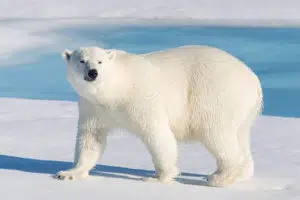
Polar bears spend so much time in the Arctic Ocean’s sea ice that they are often classified as marine mammals. But if you consider them terrestrial mammals, they’d be the largest land predators on Earth.
Polar bears have black skin under their clear guard hairs (although it looks cream-colored or white); you can only notice this by looking at their nose.
Measured from nose to tail, they are about eight feet long. Males are almost two times larger than females. A male polar bear weighs about 1,700 pounds, while females weigh about 1,000 pounds.
A water-repellant coat and a layer of fat shield polar bears from the frigid air and water. They hunt for bearded and ringed seals by standing on ice floats and diving on them. Their exceptional sense of smell also bolsters their hunting efforts. They can smell a seal that’s covered by three feet of snow from a mile away.
Polar bears evolved from brown bears millions of years ago. However, Polar bears are now considered a threatened species. This is due to the ongoing loss of habitat caused by climate change.
See Related: Fastest Animals in the World
2. Panda Bears
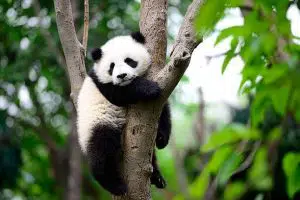
Pandas are one of the most distinctive-looking, elusive, rare, and endangered types of bear. For a long time, some scientists classified giant pandas in the raccoon family, but DNA analysis has since disproved this assertion.
Pandas are natives of southwest China, where they inhabit the temperate forests high up in the southwest mountains. They subsist mainly on bamboo, a diet with so little nutritional value that they have to consume up to 80 pounds of it daily.
Their pseudo thumb (enlarged wrist bone) functions as an opposable thumb which helps them split the bamboo. Besides, their gut is especially adapted for their diet; it is covered with a thick sheet of mucus that protects them from splinters.
Newly born pandas are blind, hairless, and petite. Males grow up to 300 pounds, and females grow up to 200 pounds. Despite their hefty weight, they are fantastic tree climbers.
Unlike most types of bears, giant pandas don’t hibernate. During winter, they migrate to lower and warmer elevations; during summer, they move to higher and cooler elevations.
See Related: These 13 Animals Have the Best Hearing in the World
3. Sun Bears
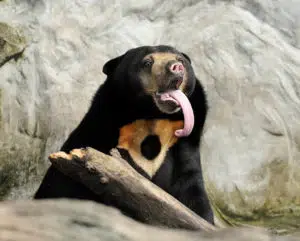
Sun bears also have another moniker, honey bears, thanks to their love for honey. Very little is known about this ancient species, which hasn’t changed much. Sun bears live a secluded life deep in Southeast Asia’s dense lowland forests.
The ‘Sun bear’ name comes from the distinctive white or golden patch that’s on their chest, which fables represent as a symbol of a rising sun. American and Asian black bears descended from the sun bears. However, they are sun bears much smaller than the American black bear.
Sun bears are distinguished by their flexible snouts, and long tongues, adapted from extracting termites. Of all the breeds of bears, they have the biggest canines adapted for tearing meat. They also have exceptionally long claws.
Very little is known about how they behave in the wild. They are nocturnal; they navigate through the forest at night, eating berries, fruits, roots, and small animals. Besides, they are known for their exceptional climbing skills.
Their habitats are degrading due to deforestation; poachers hunt them for their fur and body parts; farmers exterminate them because they often destroy food crops, and females are killed so their young ones can be turned into pets.
See Related: What Attracts Bears?
4. Andean Bear
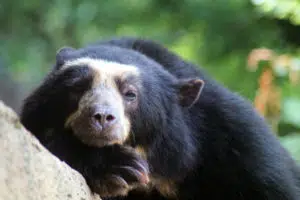
Andean bear, or the Spectacled bear is the only bear species native to South America. Spectacled bears get their name from the ‘spectacle’ marking on their face. Each bear has a unique marking, so its distinctive look can identify each of them.
Generally, spectacled bears are shy, elusive, and peaceful; they avoid contact with humans. They are also solitary, although they can congregate when their preferred food items are plentiful.
The Andrean bear is the only remaining relation to the short-faced bear (Tremarctinae subfamily); they are the closest relative of the now-extinct Pleistocene-age short-faced bears and the Florida spectacled bear.
Although adapted to a carnivorous diet, most spectacled bears now prefer a herbivorous diet. Currently, the population of Andean bears is small in most areas, and they face a lot of pressure due to habitat degradation and loss as well as hunting.
See Related: Celebrity Environmentalists You Need to Know
5. North America Black Bear
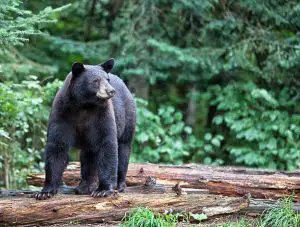
Black bears are the most common and best-known bears in North America. They live in forests, swamps, and mountains but can leave their habitat when searching for food. They are also excellent tree climbers and swimmers.
The North American Black bears are omnivorous; they can change their diet based on the season and location. In our list of bears, this type of bear is one of the two species that is least threatened with extinction. IUCN lists under the least-concern species.
6. Short-Faced Bear
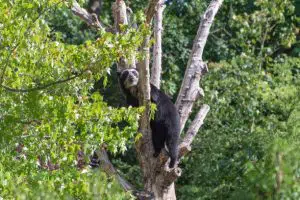
Although the Short-Faced bear is now extinct, it makes our list of different bears. During the ice age, short-faced bears thrived in North America; they were the most powerful and the largest land carnivores.
They were likely about 11 feet tall when standing and weighed some thousands of pounds. They are also the fastest bears that have ever lived. Other than being apex predators, they are also thought to have been Kleptoparasites; they intimidated other large predators into surrendering their prey to them.
See Related: Animals that Start with X
7. Asiatic Black Bear
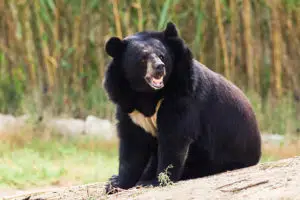
Asiatic Black bears are black-colored, medium-sized bears that are native to southern Asia. They have a white chest, and thus, they are also referred to as the moon bears.
Asiatic bears feed on a varied diet, including insects, bee nests, fruits, invertebrates, and carrion. Occasionally, they prey on domestic stock, although little is known about their hunting in the wild.
Asian black bears are victims of the bear bile trade. IUCN lists them as vulnerable.
See Related: Monk Seal Foundation
8. Brown Bear
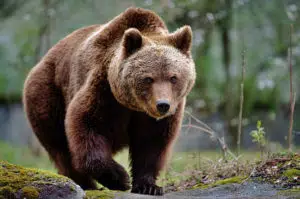
Brown bears inhabit the mountains and forests of Europe, Asia, and northern North America. They are solitary and omnivorous but congregate when food is plentiful.
For instance, there are dramatic gatherings of brown bears in Alaskan fishing spots during summer when salmons swim upstream for spawning. In fall, brown bears consume a massive amount of food, up to 90 pounds per day before hibernation in spring.
While brown bears are apex predators, most of their diet consists of roots, fruit, berries, leaves, and nuts. Even though they are huge, brown bears are incredibly fast. They can run up to 30 mph.
However, the size of brown bears varies, depending on the geographic location and food availability. The largest brown bears inhabit Russia and the coastal area of Alaska; they rival polar bears in size. The brown bears that inhabit the interior areas of North America and Europe are usually much smaller.
See Related: Australian Koala Foundation
9. Sloth Bear
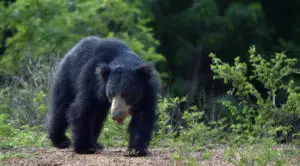
Sloth bears get their name from a sloth-like look. Like sloths, they have long, curved claws; dusty-black and shaggy coats; short-haired and pale muzzles.
Adult slots don’t have the two top front teeth. And because of their diet of fruit and insects, they have smaller molars and premolars than other bears. They, however, have huge canines that they use for defense.
The feet of adult sloth bears are turned inwards for maximum digging efficiency, and they have strong hook-like claws that allow them to dig for termites and to climb trees.
Because they have food all year round, sloth bears don’t hibernate during winter. And because they don’t suffer food fluctuations, they are smaller than other types of bears.
These bears inhabit dry and moist tall grasslands in India Sri, southern Nepal and Sri Lanka. In India, slots bears are trained to be “dancing bears,” Because they are adorable shaggy creatures, sometimes the British military kept them as pets.
However, when in the jungle, sloth bears can be highly aggressive; they can brutalize humans without any provocation. Over the last 30 years, the number of slot bears is projected to have dropped by almost 50 percent, due to poaching for parts and loss of habitat.
See Related: Famous Environmental Leaders from Around the World
10. Grizzly Bear
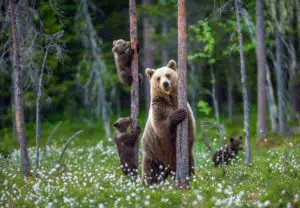
Grizzly bears are a North American brown bear subspecies. They are usually brown with grizzled or white-tipped fur. But, they can also be grey or black; what distinguishes them from other types of bears is the hump on their shoulders.
Grizzly beats thrive in the arctic tundra, open plains, subalpine meadows, and dense forests. While they are social animals, they can co-exist when food is plenty.
Much of the diet of grizzly bears consists of roots, leaves, and fruit. This is despite them being powerful apex predators. Besides, grizzly bears cover a massive home range, about 600 square miles, so they require a lot of space
Most grizzly bears can be found in Alberta, Alaska, and British Columbia. The population of grizzly bears in North America was once 50,000, currently only 1,800.
The grizzly bear population has, however, been growing since 1975 when they were classified as endangered and protected by the US Endangered Species Act.
See Related: Grizzly Bear vs. Black Bear
11. Marsican Brown Bear
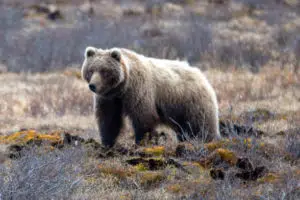
The few remaining Marsican brown bears are in the Abruzzo National Park in Italy. There are only about 50 bears left on the planet. They are relatively even-tempered, and they are not aggressive towards humans. However, they live in seclusion.
Male marsican brown bears weigh about 217 Kg, while females weigh about 140 Kg. Their diet mainly consists of berries, but they also eat insects and petite animals like chickens. Their superb sense of smell supports their food search.
Typically, Marsican brown bears wake up from their hibernation slumber several times.
See Related: Types of Terrain You Need to Know
12. Tibetan Blue Bear
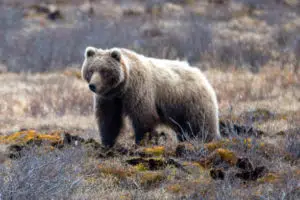
The Tibetan Blue bear is native to the Eastern Tibetan Plateau and is a brown bear subspecies. Among all types of bears, the Tibetan Blue Bear is the rarest; it’s likely extinct in the wild.
Samples of fur and bone have been found in the west, which means Tibetan Blue bears inhabited the west in the past.
They prefer living in mountainous regions, near the tree lines, but little is known about their behavior and natural habitats because they are critically endangered. The bears feed on Pika and other small mammals, and they may also eat pine nuts.
FAQs
What is the friendliest bear species?
The friendliest bear species is the black bear. Black bears are generally shy and non-aggressive toward humans. They are also known to be curious and intelligent animals.
Are there 8 types of bears?
There are eight bear types in the world. These include the American black bear, brown bear, polar bear, Asiatic black bear, sloth bear, spectacled bear, sun bear, and giant panda. Each bear type has unique physical characteristics, habitats, and behaviors.
What are the top 3 most aggressive bears?
The top 3 most aggressive bears are the polar, grizzly, and black bears. Polar bears are known to be the most aggressive due to their territorial nature and their need to defend their young.
Grizzly bears are also highly aggressive and can be provoked easily, especially if they feel threatened or their food source is threatened. Black bears are generally less aggressive than polar and grizzly bears but can become aggressive if they feel their cubs are in danger or are surprised or cornered.
How many bear types are there?
There are eight bear types in the world. These include the American black bear, brown bear, polar bear, Asiatic black bear, sloth bear, spectacled bear, sun bear, and giant panda. Each bear type has unique physical characteristics, habitats, and behaviors.
Related Resources
